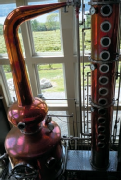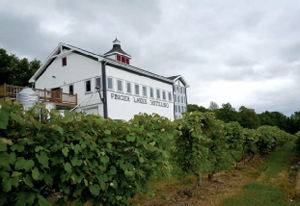On a hill above Seneca Lake, Finger Lakes Distilling turns local crops into tasty beverages
On a hill above Seneca Lake, Finger Lakes Distilling turns local crops into tasty beverages
Drive west from Ithaca until you hit Seneca Lake, hang a right, head north along the shore, and there it is: the region's only liquor distillery. On a hill overlooking the water, Finger Lakes Distilling makes and sells seventeen spirits—vodka to gin, grappa to whiskey. But don't look for rum or tequila; by law, the company's ingredients must be sourced from New York State, which nurtures neither sugar cane nor agave. "A big part of what we're doing is not just running a distillery, but creating something that jibes with a bright spot in this area: wine tourism," says president and founder Brian McKenzie '99. "In my mind, it's a tourism business as much as a distilled spirits business."

Located in Burdett on the Seneca Lake Wine Trail next door to Damiani Wine Cellars, Finger Lakes Distilling has rows of vines in its sloping front yard; its land includes a century-old vineyard, and the distillery uses the grapes in some of its products. On the bottom floor of the custom-designed building is the production facility, jammed wall to wall with stacks of barrels, most made from American oak. On this overcast day in June, the distillery is producing its 90-proof corn whiskey, dubbed Glen Thunder. To make a batch of the liquor, hundreds of pounds of corn from local farms are milled to the consistency of flour, then put into the steam-jacketed mash kettle, where the starch breaks down into sugar. Then it's into the fermenter and finally the 4,000-pound copper still, which McKenzie designed and had shipped from Germany. A clear liquor, the corn whiskey goes straight from still to bottle with no time in the barrel. "It surprises people, because they think it's going to be like pure moonshine," McKenzie says. "It has a sweetness to it. It's actually pretty smooth."

Upstairs is the tasting and sales room, its bar made of pressed tin and its floor salvaged from a Kentucky tobacco barn. Here, visitors can choose from such liquid delights as a Gewürztraminer grappa with notes of spice and apricot; a rye whiskey whose grain is grown directly across the lake from the distillery; a bourbon made from local heirloom corn and finished in Chardonnay casks; three fruit brandies (peach, pear, and currant); a maple-infused liqueur; and the distillery's top-selling item, Seneca Drums Gin, which was named best New York State spirit at the 2010 Food & Wine Classic. But tasters must weigh their options carefully; unlike at wineries, they're limited by state law to three samples of a quarter-ounce each. "Nobody's going to get smashed," McKenzie says. "They're not even getting a legal drink. A legal drink is an ounce and a half of hard alcohol, and they're getting three-quarters of an ounce."

A policy analysis and management major in the College of Human Ecology, McKenzie grew up in nearby Elmira and worked in banking and finance after graduation. But he'd always had an interest in whiskey, visiting distilleries in Kentucky and in his grandfather's native Scotland while on vacation. When the small Upstate bank he worked for was taken over, he used his severance to explore his dream job. At a distilling conference in Louisville, he met a master distiller named Thomas Earl McKenzie—no relation, but serendipitous for future whiskey-bottle labeling—and the two men hit it off. Brian decided to go for it. "Some people thought I had lost it, maybe," he recalls with a smile. "Most people were skeptical—but they thought it had some potential, too."
But there was a major stumbling block. What he planned to do—conduct tastings and sales at the distillery—was illegal in New York State. So he joined other small distillers and the state farm bureau in lobbying to create a new license classification; then-governor Eliot Spitzer signed the Farm Distillery Act in August 2007, and Finger Lakes Distilling opened two years later. It now distributes directly to some 400 retailers, bars, and restaurants throughout the state, including tony Manhattan spots like Tribeca Grill, Eleven Madison Park, Craft, Jean-Georges, and Gramercy Tavern. (Ithacans can sample McKenzie's wares at the Statler Hotel and other local establishments including Moose-wood Restaurant.) While the distillery can't ship direct to consumers, some of the stores that carry its products offer mail order; McKenzie is aiming to widen distribution—this summer, the company expanded into New Jersey and Chicago—and enlarge production space. "Our business is really seasonal," he says of the tasting-room traffic. "It kicks off on July 4 and stays busy through October. We're trying to appeal to a wide range of palates, and we get a pretty good mix of both men and women."
'Visions of Sugar Plums'
2 oz. McKenzie Rye
1 oz. ginger liqueur such as Domaine de Canton
3/4 oz. Aperol (Italian bitter orange liqueur)
Dash of simple syrup
Dash of Fee Brothers plum or Angostura bitters
Dash of ground cloves
Shake ingredients over ice and strain into martini glass. Garnish with orange peel and serve.
In addition to selling its spirits, the distillery offers a variety of high-end mixers, from boutique tonic waters to rhubarb-flavored bitters. It produces a monthly newsletter with innovative cocktail recipes like Wild Berry Lavender Lemonade (made with its berry vodka), a rosemary martini, and a gin-and-Cointreau-based concoction dubbed the Corpse Reviver #2. "There's a big interest in spirits right now," McKenzie says. "People are looking for something authentic, even historical; pre-Prohibition cocktails are really popular. It's fun to get a bottle of something and use it twenty-five different ways, versus just drinking a beer or splitting a bottle of wine."
Less fun, McKenzie admits, is the day-to-day grind of running a business—even one focused on making and selling high-end libations. "People think it's a glamorous thing to do, but there's nothing glamorous about the process side; right now, Thomas is downstairs basically covered in mash," McKenzie says of his master distiller. "There are a lot of fun things about it—getting out to sell your brand—but at the end of the day you're doing immense amounts of paperwork to keep up on all the regulations." Speaking of which, he adds: "This is a lot more regulated than banking was."
— Beth Saulnier


